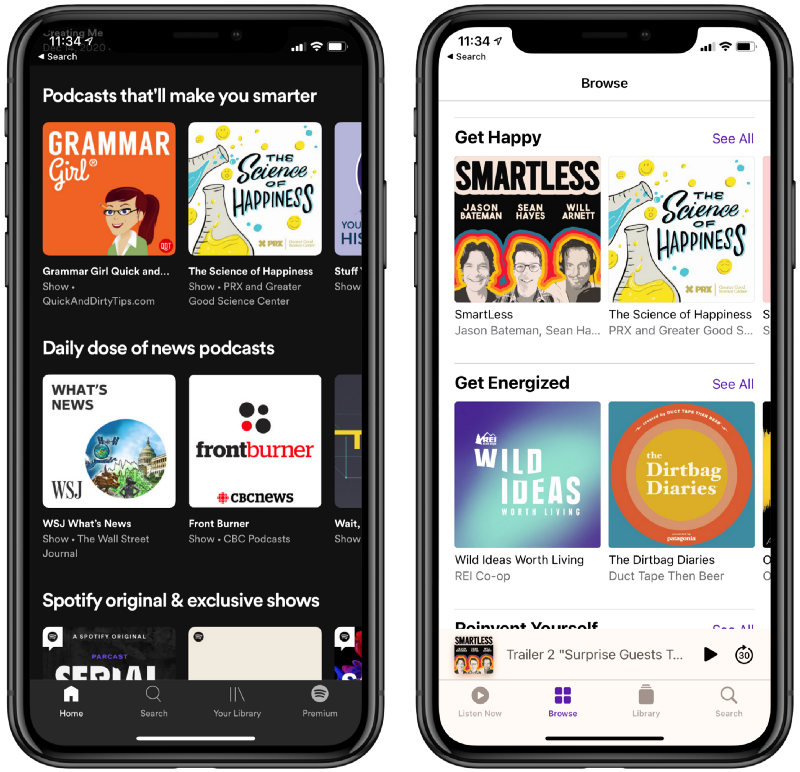This week, Apple launched Time to Walk, an “audio walking experience” available only to Fitness+ customers.
I tried it for the first time today. I walked around my neighbourhood and listened to NBA champion Draymond Green tell stories about failure and perseverance.
Though Apple doesn’t use the word “podcast” when talking about Time to Walk, my experience was very podcast-like. So too is Apple’s distribution strategy:
New episodes will appear in the Workout app on Apple Watch from a different guest each Monday through the end of April. Users can browse and enjoy previous Time to Walk episodes when it is most convenient for them.
Time to Walk episodes are automatically downloaded to Apple Watch with a Fitness+ subscription, and users can start an episode directly from the Workout app.
I’m not especially interested in arguing about whether Time to Walk technically qualifies as a podcast (it doesn’t). I suspect most Fitness+ customers don’t know or care about debating the sanctity of RSS feeds.
Instead, I’m interested in Time to Walk as an example of context-specific audio storytelling, which all podcasters (including brands) should consider.
Audio designed for a specific time, place, or activity
As its name suggests, Time to Walk is both recorded and designed to be consumed while walking. But it’s certainly not the only example of a show built around such specific activity.
For example, Gimlet’s smart-speaker-friendly Chompers is meant for children brushing their teeth:
Kids will hear jokes, riddles, stories, fun facts, silly songs and more, that’ll keep them giggling — and brushing — for the full two minutes that dentists recommend.
Podcasts like Sleep With Me (“Bedtime stories to help grown ups fall asleep in the deep, dark night”) and Nothing Much Happens (“you feel good and then you fall asleep”) are clearly intended as sleep aids.
Audio reaches people when screens can’t
One of audio’s superpowers is its ability to reach people when and where screens can’t.
We see this reflected in Edison’s research into the most common activities done while listening to podcasts, which include plenty of situations where screens simply aren’t a great fit: driving, cooking, walking outside, and relaxing before going to sleep.

For brands, these commonly-cited contexts feel full of opportunity.
Which shampoo company makes a podcast specifically designed around the average 8-minute shower time?
Which meal-kit brands could create podcast episodes paired with recipes… meant to be played on a kitchen smart speaker while cooking a specific meal?
Which sleep brands make their own shows designed for bedtime?
A parallel trend in music
In 2018, Chaz Jenkins and Jason Joven wrote about Spotify and The Rise of the Contextual Playlist, describing a shift away from genre-based playlist formats (Pop, Rock, Hip-Hop, Latin, etc.), and towards what they call “context-based (CX) playlists.”
Whether it be an activity (e.g., running, romantic dinner) or time-related event (e.g., Women’s History Month, Lunar New Year, or just a day of the week), CX playlists are quickly becoming the new paradigm in which we experience the music we knew yesterday and will discover tomorrow.
Open Apple Podcasts or Spotify, and you’ll see podcast-specific executions of this idea in their featured collections:

These collections transcend genre. For example, Spotify’s list of “Podcasts that’ll make you smarter” includes shows from several categories, including Language Learning, Social Sciences, History, Documentary, and Philosophy.
A playlist-based-show like Spotify’s The Get Up goes even further, specifically designing a listening experience intended for weekday mornings.
What are the Chances?
What does this look like for brands? Here’s an example. In 2020, Pacific Content worked with Insception Biosciences to create a 3-part documentary series called Cord Blood: What are the Chances.
Prior to working with Insception, I knew almost nothing about cord blood storage. But I soon learned there’s a narrow window of time during which cord blood can be collected, and consequently, a limited window of time during which parents can decide about their baby’s cord blood.
So we designed Cord Blood: What are the Chances for that very specific context: the months leading up to the birth of a child, during which parents are looking for information about cord blood banking.
Empathy and understanding for your listeners
Don’t get me wrong. There doesn’t need to be a 1:1 mapping of content to context. For example, I listen to daily news podcasts while I run. I listen to comedy podcasts while I do housework. I listen to finance podcasts as I fall asleep.
Your podcast needn’t be purpose-built for a specific time, place, or activity — though, for the right show, context-specificity can be a useful framing device.
Here’s the meta-point: your podcast should be designed with a strong understanding of your audience, their needs, and their desires. Who are they? Where are they? What do their daily habits and routines look like? How are they already being served? What show can you make for them that nobody else could make?
Podcasting is a medium based on loyalty, habit, and routine. Great podcasts fit into listeners’ lives and are built to do so.
What role does your podcast play in your listeners’ lives?
Sign up for the Pacific Content Newsletter: audio strategy, analysis, and insight in your inbox.




